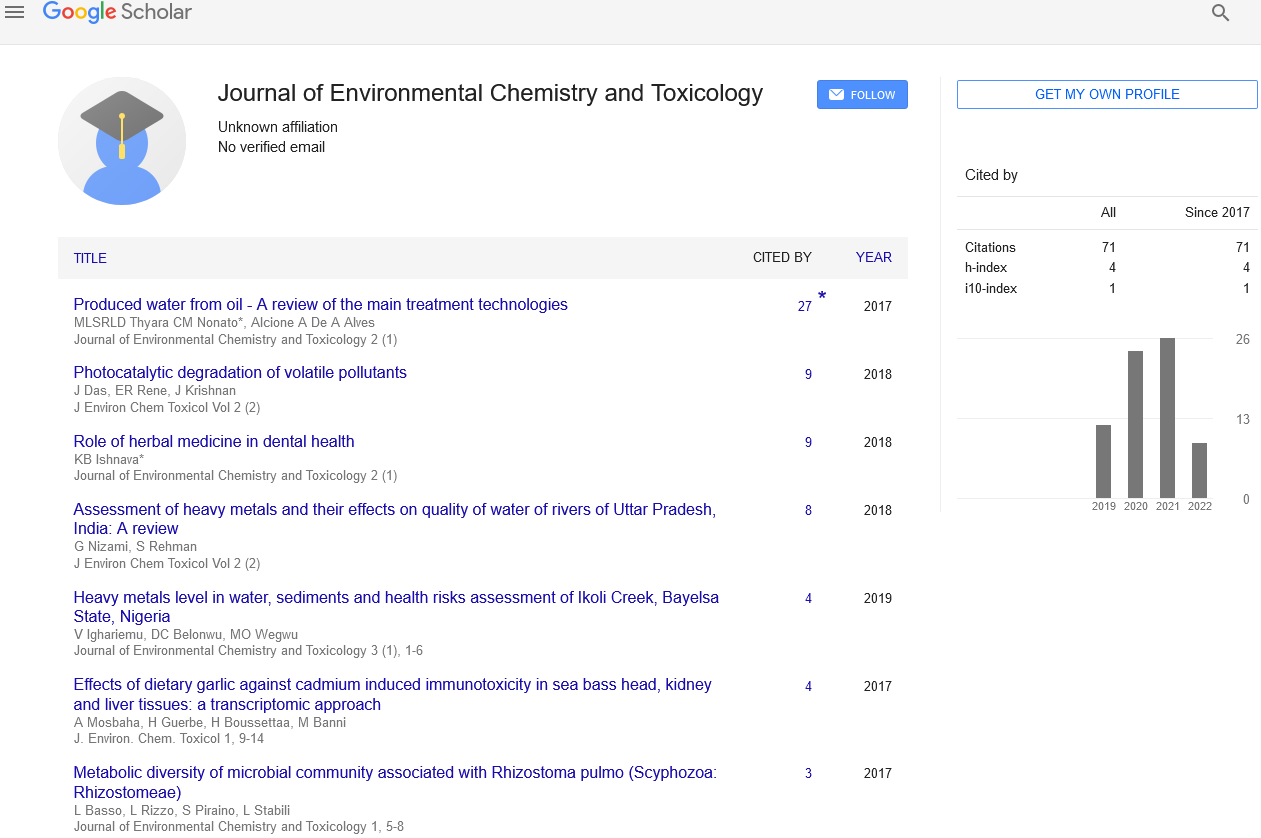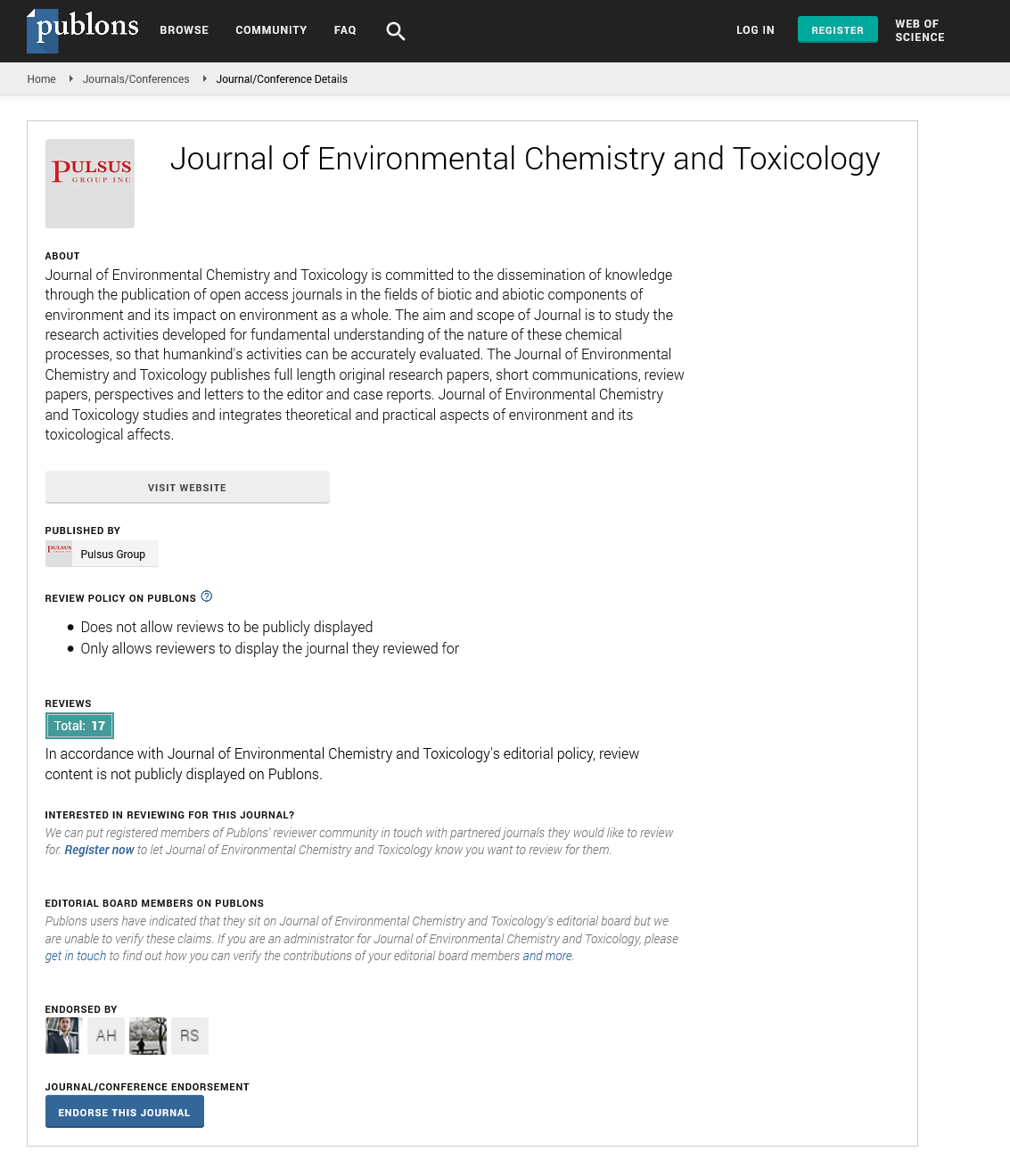Fungi Modulate Soil Volatile Organic Compounds to Influence Plant Root Architecture
Received: 02-Sep-2022, Manuscript No. PULJECT-22-5430; Editor assigned: 02-Sep-2022, Pre QC No. PULJECT-22-5430(PQ); Accepted Date: Sep 15, 2022; Reviewed: 03-Sep-2022 QC No. PULJECT-22-5430(Q); Revised: 05-Sep-2022, Manuscript No. PULJECT-22-5430(R); Published: 20-Sep-2022, DOI: 10.37532/ pulject.2022.6(5);33-34
Citation: James G. Fungi modulate soil volatile organic compounds to influence plant root architecture. J Environ Chem Toxicol. 2022; 6(5):30-31.
This open-access article is distributed under the terms of the Creative Commons Attribution Non-Commercial License (CC BY-NC) (http://creativecommons.org/licenses/by-nc/4.0/), which permits reuse, distribution and reproduction of the article, provided that the original work is properly cited and the reuse is restricted to noncommercial purposes. For commercial reuse, contact reprints@pulsus.com
Abstract
Microbial Volatile Organic Compounds (VOCs) have been shown to modulate plant development on numerous occasions. Plants have most frequently been subjected to VOCs produced by bacteria growing on media rich in nutrients to achieve this. Instead, we grew Fusarium fungi in soil to examine how the VOCs released by this system affected the growth of Arabidopsis plants. Additionally, the volatile profiles of soil-grown and malt extractgrown Fusarium strains were examined. Our findings demonstrate that different Fusarium genetic clades produce distinct volatile signatures, but they also highlight the importance of the growing medium on volatile emission. Furthermore, by lowering the concentration of VOCs in the soil, all soil-grown Fusarium isolates lengthened the primary roots of Arabidopsis. This outcome marks a significant paradigm shift. Since growth-modulating effects have previously been attributed to the emission rather than the consumption of volatile signals, plant-microbe interactions have changed.
Key Words
Bimolecular condensates
Introduction
Small molecules called volatile organic compounds, which have Shigh vapour pressure and low boiling points, include a variety of signals that are used in plant-microbial interactions. Thousands of VOCs have been identified in blooming plants and microorganisms thus far. Terpenoids, phenylpropanoids, benzenoids, fatty acids, and derivatives of amino acids are the main types of VOCs in this group. The function of VOCs emitted belowground, in contrast to their well-established roles aboveground, has just lately begun to be understood.
According to Bacillus bacteria, which stimulate plant growth by releasing 2,3-butanediol and acetoin, rhizosphere microbes may control plant growth by producing VOCs. Trichoderma viride fungus has been shown to have similar growth promotion in Arabidopsis, with growth regulators putatively identified as isobutyl alcohol, isopentyl alcohol, and 3-methylbutanal. Additionally, it has been demonstrated that Rhizoctonia solani, a fungal root disease, emits VOCs that cause Arabidopsis to produce more shoots and roots while simultaneously losing its ability to withstand above-ground herbivory. As has been shown with bacteria and mycorrhizal fungi, microbial VOCs may likewise limit plant growth and influence root development. These examples demonstrate the rhizospheric bacteria's ostensibly widespread capacity to control plant development through VOCs. Secondary metabolites control plant development in a concentrationdependent manner. As shown for benzaldehyde derivatives, inhibition occurs at higher concentrations and promotion is often recorded at low concentrations. Some VOCs, such as 13- tetradecadien-1-ol, 3-hydroxy-2-butanone, and 2,3-butanediol, have been demonstrated to have bioactive concentrations that mirror hormone levels and promote plant development in the ng-g range for microorganisms cultivated on non-soil matrices. Since the majority of the media used in earlier studies are nutrient-rich, it might be more difficult for organisms growing on soil to create secondary metabolites. The half-life of certain signalling molecules and the ability of the emitter to maintain stable VOC concentrations over prolonged periods will ultimately determine bioactivity in bulk soil and the rhizosphere.
According to phylogeny, many different microbial species appear to be able to control plant growth via VOCs, and microbial VOCs may work by altering the auxin and cytokine signalling pathways of plants. It has been demonstrated that the volatile signals of Trichoderma fungi stimulate the uptake of iron in the roots of Arabidopsis and tomato, which primes the jasmonic acid signalling pathway in plant shoots. Additionally, it has been proposed that certain bacteria, such as those living in the rhizosphere or possessing ectomycorrhizal, pathogenic, or saprophytic lifestyles, may produce unique ecologically relevant VOCs. If proven correct, this concept might support the significance of particular VOCs in interactions between plants and microbes. The impact of microbial VOCs on plant growth has been studied in several static and flow-through setups where plants and bacteria are physically separated but exchange VOCs via a common headspace. Many static systems, like a split Petri dish with plants in one compartment and microorganisms in the other, have been tried. The static methods previously mentioned had the drawback of growing microorganisms on artificial (nutrient-rich) media. The VOC profiles produced by bacteria grown on nutrient-rich media may be very different from those produced by microorganisms grown in a more natural environment (i.e., soil), which may have an impact on the phenotypic of plants. Therefore, it is important to choose growth conditions carefully while looking into potential ecologically relevant signalling chemicals.
Another flaw with static systems is that they are more susceptible to the artificial CO2 and humidity build-up that needs to be managed for accurate findings. The ability of bioactive VOCs to regulate plant growth must ultimately be identified, measured, and proven with pure chemicals at concentrations comparable to those seen in plant tests. Our study's primary objective was to look at how the growing media—soil versus a medium rich in nutrients—affected the release of fungal volatiles. The second goal was to evaluate how interactions between plants and fungi that were cultivated in soil were affected by VOCs. For our project, we used the model plant Arabidopsis thaliana, along with other Fusarium species. This genus includes ascomycete fungi of the Hypocreales order that are found all over the world and have a variety of lifestyles, from saprophytes and plant pathogens to symptomless endophytes. Since the colonised host plant and potentially other environmental factors are so important to the Fusarium genus' lifecycle, it is impossible to categorically classify its members as either saprophytes or pathogens.






